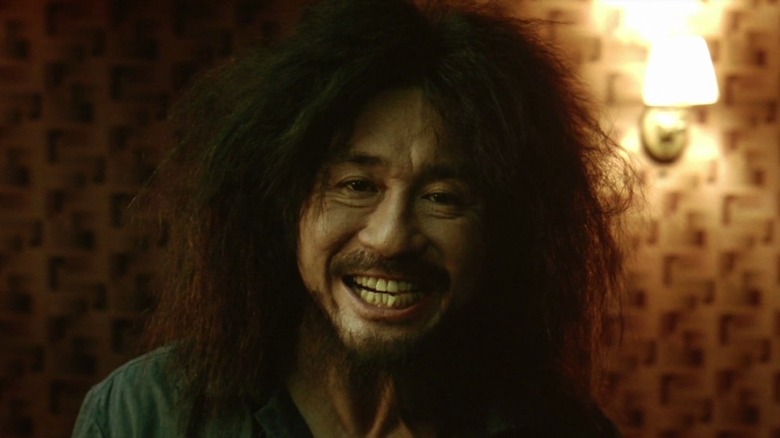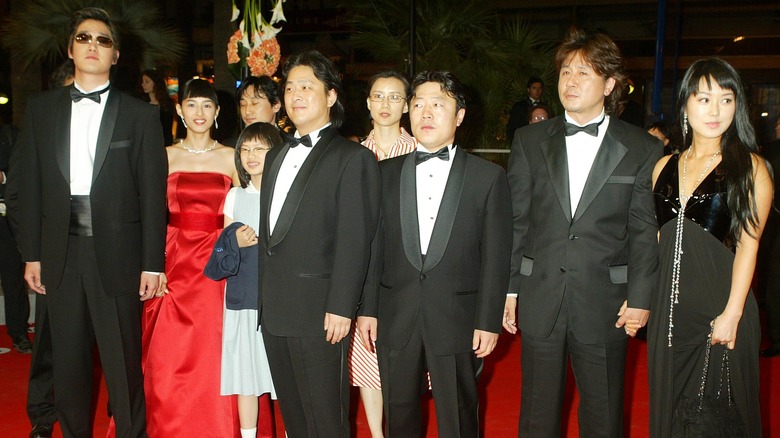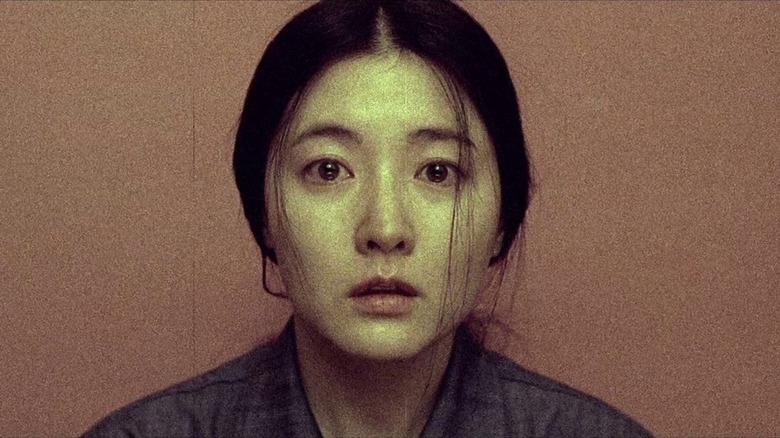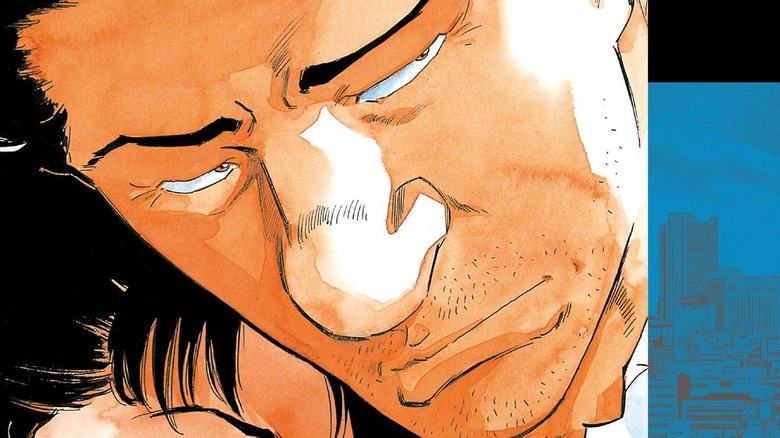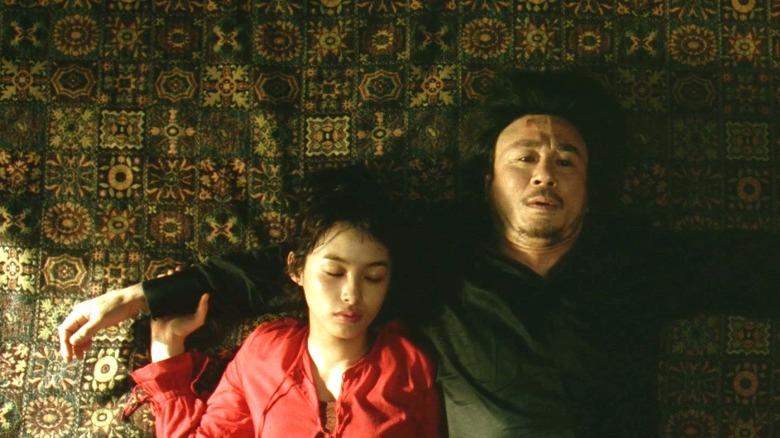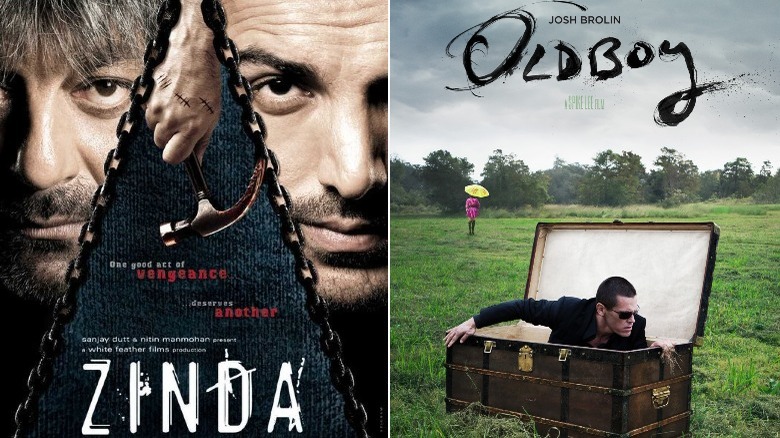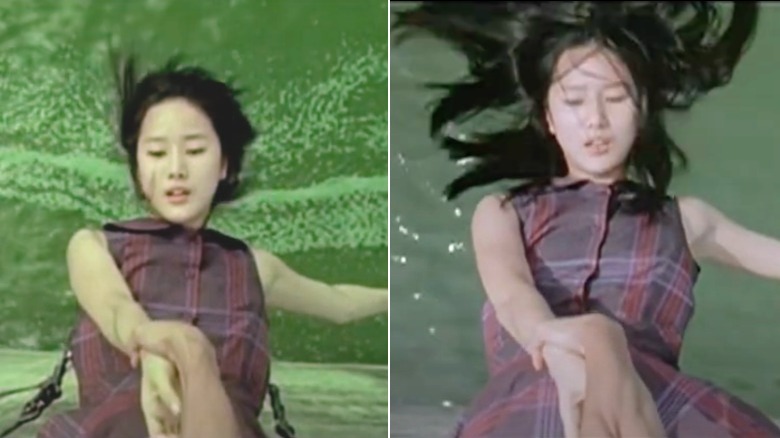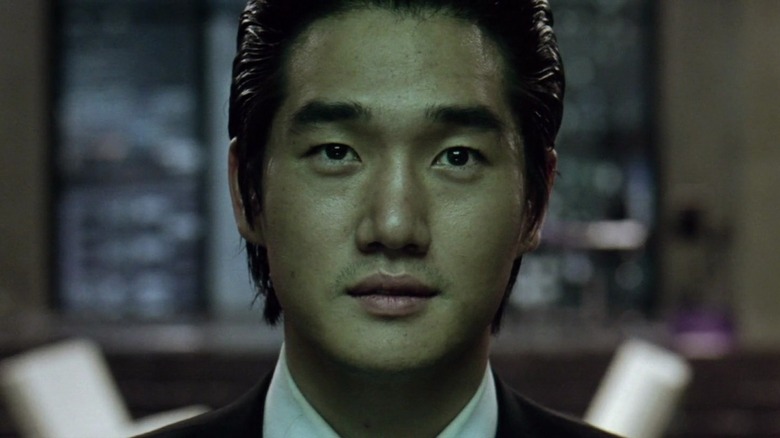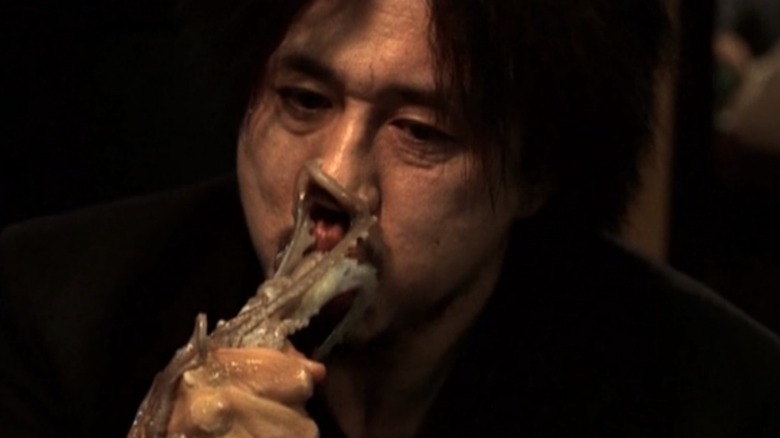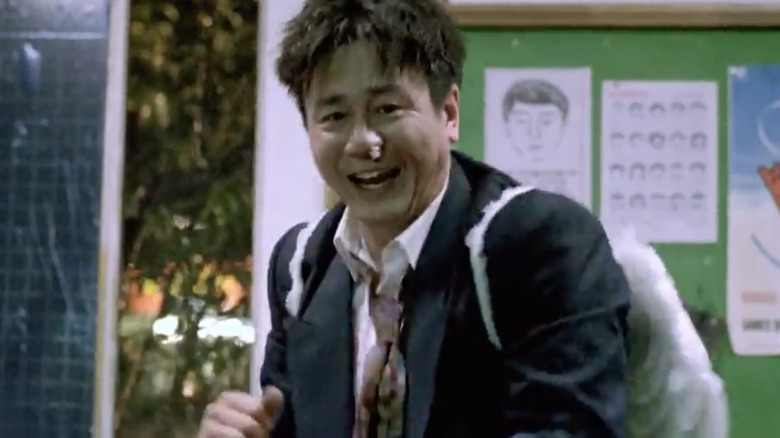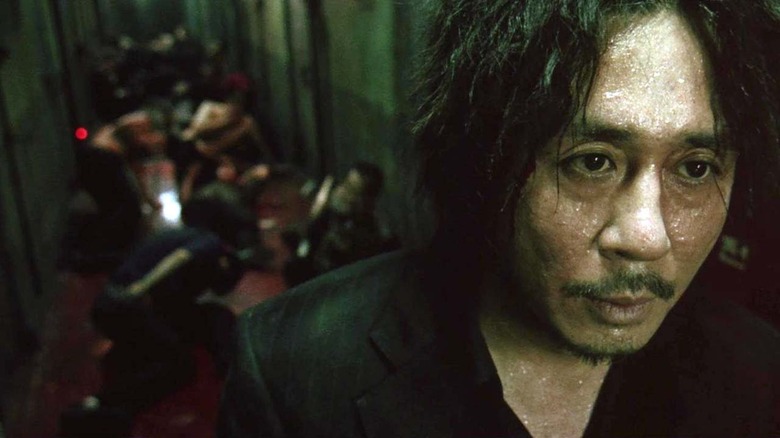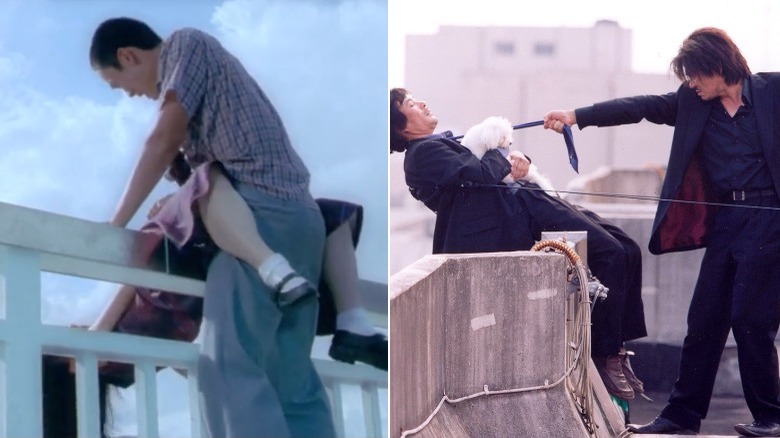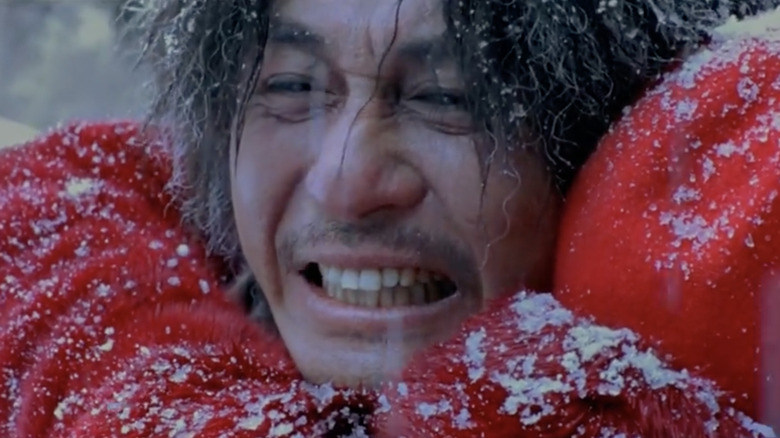The Untold Truth Of Oldboy
It's been a little under 20 years since the initial release of Park Chan-wook's controversial and critically acclaimed "Oldboy," and according to the Hollywood Reporter, those of us who weren't lucky enough to see it in theaters when it was first released back in 2003 will have the opportunity to see it on the big screen in all its gory wonder sometime in the near future.
"Oldboy" was released to great commercial and critical success, with critics like Roger Ebert describing it as "a powerful film not because of what it depicts, but because of the depths of the human heart which it strips bare." Surprisingly, according to the creators themselves, they had major doubts that they would be able to pull off such an extreme and lavish production successfully, due to many aspects of the project posing significant challenges. Thankfully, though, they were successful, and the project achieved a status none of them had foreseen. Today, "Oldboy" is considered one of the great cinematic masterpieces of the early 2000s.
It Achieved International Success
"Oldboy" was a smashing success as soon as it was released, becoming the fifth highest-grossing South Korean film in 2003. The film and its crew were invited to the 2004 Cannes Film Festival, and Park Chan-wook confessed in an interview released with the DVD that he had suspicions that they would be receiving an award after he was warned by an organizer not to leave early that evening. Though they had some hint of their film's success at Cannes, the Grand Prix award was an astonishing honor, putting them in second place behind the Palme d'Or winner, Michael Moore's groundbreaking documentary Fahrenheit 9/11. "I was shaking," said actress Kang Hye-jung of the experience, "not because I was scared, but because I was ecstatic."
All in all, the film was nominated for a total of 49 awards from various organizations, winning 28 of those honors, including best film at the Korean Film Awards as well as at the Sitges Film Festival.
It's Part of a Trilogy
Park Chan-wook has a particular love for revenge stories. In an interview with Mark Salisbury, Park even said that he doesn't understand why other directors don't. In part because of this fascination, and because he wanted to find a way to express the repressed anger of the modern era, he created "The Vengeance Trilogy," of which "Oldboy" is the second installment. The first film in the series, "Sympathy for Mr. Vengeance," is about a factory worker who enters a life of crime in the hopes of paying for his sister's kidney transplant. The third film, "Lady Vengeance," follows a single mother on a mission of revenge against the man who framed her for the murder of a six-year-old boy.
While neither of the other two installments in the series found the success that "Oldboy" did, Park stands by them. After mentioning that the first installment, "Sympathy for Mr. Vengeance," was said to have flopped because it was "too real for the audience," Park stated that he "wanted to make something that felt too real ... I wanted their bodies to be tired. I thought people would love that, I like that kind of experience ... I wanted a tiring film, I suppose it was a success in that sense."
Based on a Manga
That's right, "Oldboy" is adapted from the similarly titled manga "Old Boy" by Garon Tsuchiya. Though the movie and the originating manga differ greatly, the film owes much of its design and structure to the comic, even if it approached both from a new perspective. The film and manga have the same premise, although the movie's famous final twist and its characters are entirely original. According to production designer Ryu Seong-hie, while the book was a source of inspiration, they knew all along that the film wasn't going to be a straight adaptation. "The plan was we'd read the comic then make a great film noir with the story."
Ryu and her team used various methods of design to incorporate the surreality of manga into a film otherwise based primarily in realism. Heavy patterns and tinted lighting along with a bold color palette were used to accentuate the otherworldly aesthetic, while experimental camerawork kept the audience on their toes. In his interview with Mark Salisbury, Park said that he thought he would be able to shoot it easily like the manga, but after the production got underway, he realized it would work better with an alternative design. The hard work paid off: "Oldboy" was heavily praised for its look and six of its 49 award nominations were given to its visual effects.
It Pulled From Many Inspirations
Beyond the inspiration already taken from the existing manga, the production team pulled design and story concepts from several other sources. In the DVD production design documentary, costumer Jo Sang-gyeong says she referred to "American Psycho" for dressing villain Woo-jin, saying that the film was a "perfect fit" for the character's clean, severe look. Along with that, the book "The Count of Monte Cristo" and the classic story of "Oedipus" both play major roles in the story.
The influence of "The Count of Monte Cristo" appears in the film in the IM username that Woo-jin uses to communicate with Mi-do, and even as the name of a track on the score. The central theme of long-term revenge surrounding a romantic tragedy is clearly a part of the final product. "Oedipus" shows itself both in the protagonist's phonetically inspired name and in the famous final twist of the film: The secretly incestuous nature of the relationship between Oh Dae-su and Mi-do.
It Was Remade Twice
Though you've probably at least heard of Spike Lee's critically derided remake in 2013, did you know that a second remake titled "Zinda" popped up in India in 2006? If you didn't, it's likely because the film was never officially licensed and was immediately accused of plagiarism upon its release. As Derek Elley pointed out in his review of "Zinda" for Variety, the film holds many, shall we say, similarities to "Oldboy," including several nearly identical shots. Ultra, the production company behind "Zinda," ceased to exist not long after the film was released, although no legal action was taken by the original production team.
Spike Lee's remake was a bit more straightforward, and definitely official. While it is very nearly a shot-for-shot adaptation of the original, several major plot points were altered so that the incestuous themes were resolved differently. The fact that neither remake includes the whole of the final twist likely came as no surprise to Park Chan-wook. When asked by Mark Salisbury how he felt about the then-upcoming American remake, Park expressed concern: Considering how much he struggled to get the film greenlit by his production company due to the incest twist, he pitied the future director for the difficulties they would face.
CGI Was Used Sparingly
According to an interview with Technical FX Director Chunk Sung-jin, he and his team approached the need for hyper-realistic effects on this project with the primary goal of supporting the film, a refreshing approach when so many other films use it as a focal point. Chunk said the crew "did our own thinking on how to help these kinds of scenes with computer graphics." Most of the visual effects were only enhanced with CGI, with the FX team assigned mostly to altering colors, removing background distractions, or smoothing lighting. That's not to say it was an easy job: A major shot showing the moment before Lee Soo-ah falls to her death took approximately a month just to remove the foam from the water in the background.
3D effects were used sparingly, primarily within the two ant scenes. The large ant that Mi-do sees in her subway vision is entirely practical, other than the hairs, which were added on as a finishing touch. In Dae-su's hallucination of ants crawling out of his skin, both his arm and the ants were created with CGI. In place of additional 3D modeling, practical effects were used to add to the exaggerated realism of the film, including the use of a wire to enable Woo-jin to successfully execute the complex Locust Pose, as seen in this featurette.
Yoo Ji-tae Was Cast Against Type
Yoo Ji-tae was not exactly new to the film industry when he was cast in "Oldboy" in 2002, but he certainly had never been put in as blatant a villain role as Lee Woo-jin. Through the '90s, Yoo was a successful fashion model, and it wasn't until 2000 that he hit it big with "Ditto," Kim Jung-kwon's soon-to-be-remade sci-fi romance that showed off Yoo's sensitivity and charisma. Projects such as "Attack the Gas Station" cemented his public persona as a swooning romantic lead, so understandably his fan club was shocked when he appeared on screen as a vicious murderer out for revenge. In one of the behind-the-scenes featurettes, multiple members of his fan base were interviewed. "I wanted to get in the film and hit him," said one fan. Another adds, "It wasn't Yoo Ji-tae's usual role. It was totally different."
Park Chan-wook says Yoo's surprise casting came at the suggestion of star Choi Min-sik during a period when the creative team was struggling to settle Lee Woo-jin's characteristics. They needed an actor who could convey his necessary complexities well, even with minimal screen time. Once the suggestion of Yoo was made, though, the crew immediately saw him as an obvious solution. His charm, style, and smooth persona were used to further develop the character, leading to an iconic depiction of a villain audiences love to hate.
The Octopus was Real.
If you've seen "Oldboy" you remember the octopus scene: It's hardly subtle. Dae-su follows a trail of clues to a sushi restaurant, where he showcases his emotional instability by requesting to eat something alive. After a beat of shock from Dae-su's new friend Mi-do, he is handed a wriggling, living octopus which he proceeds to eat whole. While this might cause some shock for viewers from differing cultural backgrounds, this is an extreme example of a fairly common practice in South Korea. Yes, the octopodes in "Oldboy" were real creatures, raised to be eaten alive. In his interview with Mark Salisbury, Park said that "Korean people do eat live octopus, but not such big ones and we cut them into pieces.... it was a little bit of exaggeration in that particular scene."
Choi Min-sik was raised Buddhist, which means he would typically never consume anything living, and has discussed the process of filming this scene in multiple interviews. According to Park, Choi paused to apologize, thank, and pray over each of the octopodes after each take. Four were used in total, partially due to the fact that the first three were not active enough to be visually appealing on screen.
Choi Min-sik Did it All
Award-winning actor Choi Min-sik is an undeniable powerhouse who brings thought and complexity to all of his roles. He's won nearly 40 awards for performances, a whopping 10 of which were awarded for "Oldboy" alone. The behind-the-scenes documentaries, film commentaries, and interviews associated with "Oldboy" reveal that Choi had a huge amount of input on the project, with many of the most iconic portions of the film attributed to his ideas.
In the version of the film's commentary with both Choi and Park, they tell many stories relating to the development of the film's concept, even through the filming process. It is revealed that the opening scene of the film where Dae-su causes a drunken disturbance in a police station was not only the last segment to be filmed, it was almost entirely improvised by the actor. Additionally, Choi insisted on executing his own stunts whenever possible, driving himself to exhaustion in order to ensure a perfect take of the infamous single-shot corridor fight scene. The actor even stated in the "Flashback" featurette that the filming process was so demanding he would frequently fall asleep on set.
One Take Was Just Practical
Though it's so iconic it seems like it must have always existed within the concept for the film, the infamous single-shot corridor scene was originally supposed to involve CGI and more than 100 cuts. In the behind-the-scenes featurette "Flashback," both Park and Choi discuss coming to an agreement that a more simplified, realistic version of the scene sounded way better. The practical effects meant that the exhaustion experienced by Oh Dae-su would have an added touch of realism because of the actor's genuine fatigue, and it also saved the filming crew hours of labor it would take to reset the camera after each new shot.
Computer graphics were used to insert a knife into the hand of one of Dae-su's attackers, but other than that and some aesthetic touch-ups, the scene was done practically. It took 17 takes over three days to get perfectly. Park says he "explained to him that we could put the shots together on the computer, but [Choi] said he was doing it," to which Choi simply adds, "I was out of my mind."
Sane or not, the choice paid off, and the corridor scene lives as one of the most masterfully shot fights in cinematic history.
There are Many Mirrors
Mirroring is a commonly used narrative tool that draws attention to two different characters or events by highlighting their similarities. "Oldboy" is a film of many mirrors which, when noticed, point the viewer subtly towards the inevitable culmination of the plot. Mi-do and Soo-ah are obvious examples, and are clearly similar even before the reveal of their mutually incestuous relationships. They are idealistic young girls making poor choices in part because they've fallen in love with someone, and because of those choices, their lives are in danger.
It's the two male leads, though, who have the most in-depth development as mirrors. Both characters walk a similar path and encounter similar challenges. While part of that is due to Woo-jin's plotting, much of it simply comes from the fact that they are two wounded men who have been through a massive amount of trauma from which they will ultimately be unable to recover. Though it might not be obvious to a casual viewer, costumer Jo Sang-gyeong points out in one of the featurettes that the mirroring extends even to Woo-jin and Dae-su's designs. They wear the same clothing, though Dae-su's lifestyle makes his expensive suits wear a bit differently, further highlighting his differences with Woo-jin.
Cosmic Judgment
For as violent a movie as "Oldboy" is, it's remarkably minimalistic when it comes to actual deaths. Its most chaotic scenes are frequently revisited later in the plot as a source of comic relief, so even the characters unlucky enough to go up against Oh Dae-su in the corridor scene make it out alive. Characters' eventual punishments are handled with extreme care to make each more horrifying than the last, so that they have a macabre irony that would make John Doe of "Se7en" envious of their design.
Ji Dae-han is killed with a CD after helping Dae-su gather information. Park Cheol-woong, the pitiful and ultimately powerless enabler of countless crimes, is proved toothless when Dae-su forcibly removes his teeth. Mr. Han repeatedly turns a deaf ear, and his complacency in Woo-jin's crimes is cosmically punished by being stabbed in the ear. Dae-su cuts his own overactive tongue out, and Woo-jin's death is — like the rest of the plot — his own doing. In the end, the ultimate cosmic judgment is shown following Dae-su's attempt to soften his fate through escapism. Instead of expressing joy, his face morphs into the same crazed, laughing man whose painting haunted him throughout his imprisonment, letting the audience know that regardless of the outcome of his plans, he will always be trapped in that prison.
